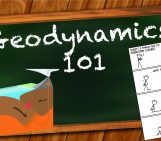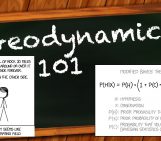
We all want our five minutes in the spotlight. It could be the long-awaited moment you finally get to give an oral presentation at EGU, in front of an audience eager to absorb every single word that comes out of your mouth and every single slide like they are solving all open issues in all the geosciences. But not all research fields are created equal and, let’s face it, some fields seem to be considered the soggy leftover of a disappointing dinner that nobody wants to finish. Eva, in particular, is obviously frustrated that her research field does not get the attention it deserves and asks:
Why does everyone always forget that core dynamics are also a part of geodynamics?
Dear Eva,
That is an excellent question. Why does it seem that the study of the deepest part of the Earth of which, in spite of the fact that it accounts for a hefty portion of our planet and it generously provides us with a geomagnetic field, we know very little about, does not receive a lot of attention among geodynamicists? You are not alone, though, as some have already made the case for core-dynamics as rightful part of geodynamics, not without some frustration.
Let me now quash any comment along the lines of “this is not true, Eva is just whining”. The numbers speak for themselves: try and look for specific core dynamics sessions in past EGU general meetings’ programme. (Spoiler alert: to find the one ‘canonical’ core dynamics session, the right keyword is “Earth’s core”. You even have to be careful about what you look for). Now type the words “subduction”, “mantle” or “tectonics” and count the results. I don’t have an exact number, but it’s a lot.
Now, to the reason of this. Again, it’s a matter of numbers. Compared to other fields of geodynamics, core dynamicists are simply not that many. It is therefore natural that dedicated sessions in big meetings are not as numerous. As a result core dynamics may feel like a small footnote of the big EGU general meeting program, easy to overlook. There is no malice there: would you even know who the Kardashians are if you weren’t force-fed juicy and important news about them? I know I wouldn’t.
There are other reasons though. The study of the dynamics of the core includes magneto-hydrodynamics (fancy name for magnetism in a fluid) which is not really something tectono-physicists tend to stumble upon very often. Core dynamics has turbulence. I mean proper turbulence, not the Mickey-Mouse turbulence of the mantle. That’s also a very werid beast, and it comes with a lot of even weirder math. Folks studying rocks and subduction zones tend not to be big fans of it. As a results it is not uncommon for core-dynamics papers to be considered “hard to understand” or “too theoretical”. I will concur for this being a big reason for you not to read a paper. I bet it’s been a while since you skimmed through the Journal of Number Theory.
These may or may not be good reason to let core dynamicists talk to each other in a locked room, with the occasional treat being tossed at them from the superstars of mainstream geodynamics. Core dynamics papers really are more theoretical than many others. However, it is also fair to say this is because the study of the core is not yet at the level of, for example, mantle dynamics, where you can actually study details like phase transitions. On the other hand, we don’t even know what exactly puts the fluid core in motion! Is it thermal or chemical convection? Who knows?
Looking at EGU alone there is also an issue of classification: core-dynamics presentations may be sprinkled here and there in GD, EMRP, PS, G and ST sessions. This raises the issue of representation of core-dynamics as GD proper, and it’s harder to decide what’s ‘home’ for core dynamicists.
Oh, and on the topic of turbulence: yes…the outer core is fluid. Not a solid. Congratulations on noticing it. Does this make it less part of geodynamics? Let’s see…core: part of the Earth’s interior (surely, right?). Seems to me we’ve got the “geo” bit. It’s a turbulent and highly dynamic environment. Correct me if I am wrong, but I would say that checks the “dynamics” part as well. So…”geo”+”dynamics” makes “geodynamics”. Am I making some fundamental mistake here? No? Good.
So let’s all make an effort and vow here and now that we will all visit at least one core dynamics talk or poster during next EGU assembly. These folks need to feel at home in GD! Or somewhere. Anywhere.
Yours truly,
The Sassy Scientist
PS: Core dynamicists have feelings too. Buy better treats every now and then and don’t abandon them on the side of a road in summer.
PS2: For some not-too-theoretical core-dynamics material on the GD blog: this, this and this (maybe? sort of?)
PS3: I am not forgetting about the inner core. That’s solid, and highly dynamic too. Should we then carve out the outer core but retain the solid chunk of iron in the definition of “geodynamics”?





